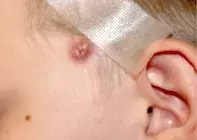What’s the diagnosis?
A young boy with a painful facial lesion

Case presentation
A six-year-old boy presents with a slowly enlarging lesion in the preauricular area (Figure). The lesion was initially asymptomatic but has recently ulcerated and become painful. He has been treated with a five-day course of flucloxacillin, with no improvement.
Differential diagnosis
Conditions to consider in the differential diagnosis for a child of this age include the following.
- Juvenile xanthogranuloma. This benign self-resolving tumour of early childhood has a highly variable clinical appearance. Some lesions appear as papules or nodules; others are subcutaneous and more difficult to distinguish. The lesions may appear red initially but evolve to a characteristic yellow-brown colour. They typically undergo an initial period of rapid growth and may ulcerate, causing minor bleeding. A juvenile xanthogranuloma can occur internally, usually without complications, but ocular lesions (although rare) may lead to raised intraocular pressure. Therefore, it is standard protocol that children with a juvenile xanthogranuloma be referred to an ophthalmologist for review.
- Squamous cell carcinoma. Although skin malignancy is very rare in young children, it should always be considered in the differential diagnosis of any new skin lesion, particularly when there is a history of recent ulceration, as in this case. A squamous cell carcinoma typically arises in photodamaged skin with associated plaque-like, verrucous or ulcerated areas and grows over a period of weeks to months. The diagnosis is confirmed by skin biopsy. A squamous cell carcinoma in a child is reason to suspect a DNA repair deficiency, and referral to a paediatric dermatologist should be arranged.
- Ruptured epidermal cyst. Epidermal cysts, which contain keratin and its breakdown products and are surrounded by an epidermoid wall, result from squamous hyperplasia in a damaged sebaceous gland. They are the most common cutaneous cyst in adults but are uncommon in children. Calcification of the cyst contents can occur. Rupture of the cyst wall can give rise to intense inflammation. The prognosis is usually excellent and uncomplicated cysts may not require any intervention; however, an inflamed cyst is preferably incised and drained. If there is clinical evidence that secondary infection has occurred (e.g. pain, surrounding erythema) then a swab should be performed and antibiotics commenced if the infection is confirmed.
- Atypical mycobacterial infection. This is an unlikely diagnosis, but an atypical (nontuberculous) mycobacterial infection should be considered in an ulcerated painful lesion that does not respond to a course of antibiotics. Nontuberculous mycobacteria are typically environmental organisms residing in soil and water. Lesions caused by such organisms present as persistent nodules and ulcers. An atypical infection should be considered in any persistent, ulcerated nodule. Diagnosis is made on culture of biopsy material.
- Spitz naevus. This benign melanocytic lesion can be amelanotic and appear as a pink or red nodule. It occurs typically on the face and upper limbs and is common in children (approximately 50% of lesions occur in patients under the age of 14 years). The classic spitz naevus is a symmetrical and well-defined compound naevus. They occur predominantly in white populations but have also been reported in black and Asian populations.
- Foreign body granuloma. Although adults are usually aware when their skin has been pierced by a foreign body, this is not always the case for children. A foreign body reaction is a collection of granulation tissue as the immune system walls off the object, and ulceration is common when it is ejected.
- Pilomatrixoma. This is the correct diagnosis. Pilomatrixoma is an uncommon benign, superficial adnexal skin tumour of the hair follicle derived from hair matrix cells. It can occur at any age but is most often seen in people under 20 years of age; females are affected more often than males. The lesions range in appearance from skin-colour to red and often have a bluish colour due to accumulation of calcium. They are usually located on the head, neck or upper limbs. Pilomatrixoma grow slowly and usually present as a solitary, deep dermal or subcutaneous lesion (between 3 and 30 mm in diameter) with a firm to stone-hard consistency due to calcification and a lobular shape on palpation and normal overlying skin. The lesions may ulcerate, usually when calcium is extruded through the skin.
Management
Pilomatrixoma can often be diagnosed by ultrasound, particularly when calcification is present, but definitive diagnosis is made by biopsy. Complete surgical excision is curative but the lesion has a tendency for local recurrence if excision is incomplete.1 The decision to remove an uncomplicated lesion is therefore a cosmetic one. Although the tumours are considered to be benign, rare malignant change has been reported and appears to arise in large pilomatrixomas that have been present for many years.2 For the child described above, whose lesion was ulcerated and painful, excision was performed and provided a rapid, effective solution.
References
1. Pirouzmanesh A, Reinisch JF, Gonzalez-Gomez I, Smith EM, Meara JG. Pilomatrixoma: a review of 346 cases. Plast Reconstr Surg 2003; 112: 1784-1789.
2. Hardisson D, Linares D, Cuevas-Santos J, Contreras F. Pilomatrix carcinoma: a clinicopathologic study of six cases and review of the literature. Am J Dermatopathol 2001; 23: 394-401.
Skin lesions

